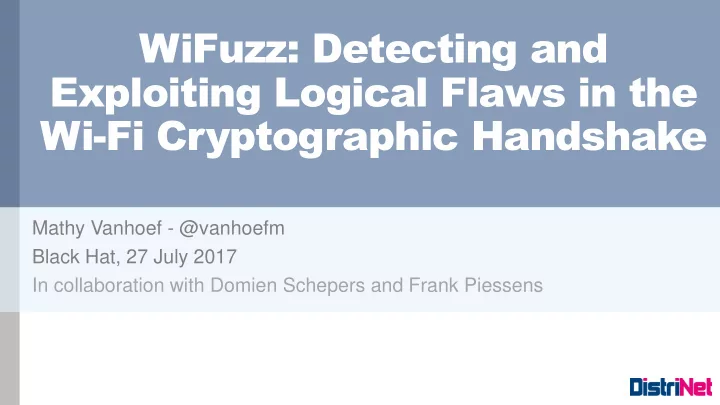

WiFuzz: Detecting and Exploiting Logical Flaws in the Wi-Fi Cryptographic Handshake Mathy Vanhoef - @vanhoefm Black Hat, 27 July 2017 In collaboration with Domien Schepers and Frank Piessens
Introduction More and more Wi-Fi network use encryption: 75% 2010 50% Most rely on the Wi-Fi handshake to generate session keys
How secure is the Wi-Fi handshake? Design: formally analyzed and proven secure 1 Security of implementations? Some works fuzz network discovery stage 2 Many stages are not tested, e.g. 4-way handshake. But do not tests for logical implementation bugs Objective: test implementations of the full Wi-Fi handshake for logical vulnerabilities 1 C. He, M. Sundararajan, A. Datta, A Derek, and J. Mitchell. A modular correctness proof of IEEE 802.11i and TLS. 3 2 L. Butti and J. Tinnes. Discovering and exploiting 802.11 wireless driver vulnerabilities.
Background: the Wi-Fi handshake Main purposes: Network discovery Mutual authentication & negotiation of pairwise session keys Securely select cipher to encrypt data frames WPA-TKIP AES-CCMP Short-term solution: reduced security Long-term solution based on so it could run on old hardware modern cryptographic primitives 4
Wi-Fi handshake (simplified) 5
Wi-Fi handshake (simplified) Defined using EAPOL frames 6
Frame Layouts EAPOL frame: … header replay counter MIC key data encrypted WPA-TKIP frame: RC4 encryption (insecure) MIC key Data MIC If decrypted, reveals MIC key. 7
How to test implementations? Model-based testing! Test if program behaves according to some abstract model Proved successful against TLS Apply model-based approach on the Wi-Fi handshake 8
Model-based testing: our approach Model: normal Set of test handshake cases Test generation rules: (in)correct modifications Test generation rules: Test various edge cases, allows some creativity Are assumed to be independent (avoid state explosion) A test case defines: 1. Messages to send & expected replies 2. Results in successful connection? 9
Executing test cases For every test case unexpected reply Execute test case unexpected result Check if connection Save failed test successful All OK Reset Afterwards Inspect failed test cases Experts determines impact and exploitability 10
Test generation rules Test generation rules manipulating messages as a whole: 1. Drop a message 2. Inject/repeat a message Test generation rules that modify fields in messages: 1. Bad EAPOL replay counter 2. Bad EAPOL header (e.g. message ID) 3. Bad EAPOL Message Integrity Check (MIC) 4. Mismatch in selected cipher suite 5. … 11
Evaluation We tested 12 access points: Open source: OpenBSD , Linux’s Hostapd Leaked source: Broadcom, MediaTek (home routers) Closed source: Windows, Apple, … Professional equipment: Aerohive, Aironet Discovered several issues! 12
Missing downgrade checks 1. MediaTek & Telenet don’t verify selected cipher in message 2 2. MediaTek also ignores supported ciphers in message 3 Trivial downgrade attack against MediaTek clients 13
Windows 7 targeted DoS Client AP Client 2 … 14
Windows 7 targeted DoS Client AP Client 2 PoC & Demo github.com/vanhoefm/blackhat17-pocs … 15
Broadcom downgrade Broadcom cannot distinguish message 2 and 4 Can be abused to downgrade the AP to TKIP Hence message 4 is essential in preventing downgrade attacks This highlights incorrect claims in the 802.11 standard: “ While Message 4 serves no cryptographic purpose , it serves as an acknowledgment to Message 3. It is required to ensure reliability and to inform the Authenticator that the Supplicant has installed the PTK and GTK and hence can receive encrypted frames. ” 16
OpenBSD: DoS against AP Two bugs in OpenBSD: 1. TKIP countermeasures are never stopped Recall: it uses a weak Message Integrity Check (MIC) If ( two MIC failures within a minute) halt all traffic for 1 minute forever 2. MIC failure report accepted before 4-way handshake Combined: unauthenticated permanent DoS 17
OpenBSD: DoS against AP 18
OpenBSD: DoS against AP PoC & Demo github.com/vanhoefm/blackhat17-pocs 19
OpenBSD: client man-in-the-middle Manual inspection of OpenBSD client: State machine missing! Man-in-the-middle against client 20
OpenBSD: client man-in-the-middle 21
OpenBSD: client man-in-the-middle PoC & Demo github.com/vanhoefm/blackhat17-pocs 22
More results See Black Hat & AsiaCCS paper 1 : Benign irregularities fingerprint Permanent DoS attack against Broadcom DoS attack against Windows 10, Broadcom, Aerohive Inconsistent parsing of supported cipher suite list … 1 M. Vanhoef, D. Shepers, and F. Piessens. Discovering Logical Vulnerabilities in the Wi-Fi Handshake Using Model-Based Testing. 23
Future work! Current limitations: Amount of code coverage is unknown Only used well-formed (albeit invalid) packets Test generation rules applied independently Only tested Access Points (not clients) But already a promising technique Black-box testing mechanism: no source code needed Fairly simple handshake, but still several logical bugs! 24
Conclusion Wi-Fi code less secure than expected New attacks (will) keep appearing Need better tools to detect logical flaws Current testing framework is basic Complex bugs remain undetected Ongoing results: contact me if your product uses Client-side version of WPA1/2 Other Wi-Fi handshakes: 802.11r, PeerKey , … 25
WiFuzz: Detecting and Exploiting Logical Flaws in the Wi-Fi Cryptographic Handshake Mathy Vanhoef Questions? vanhoefm
Recommend
More recommend